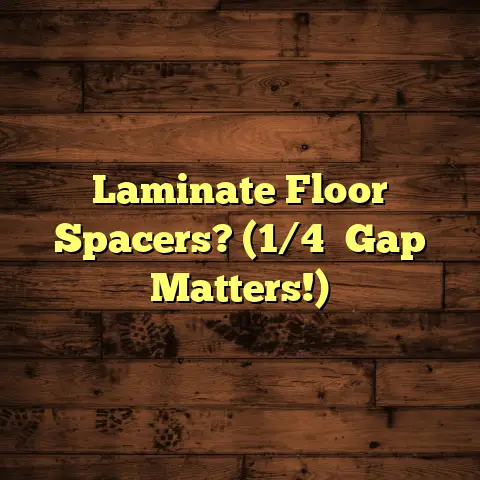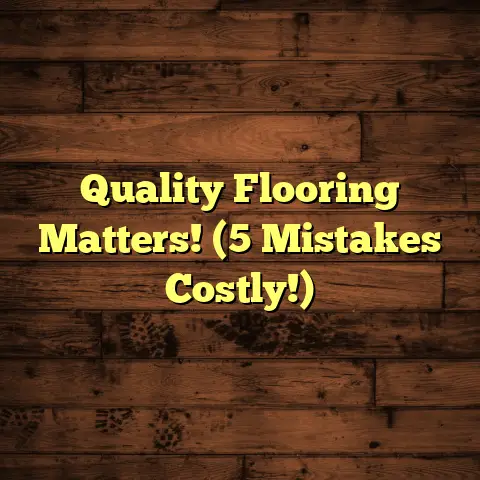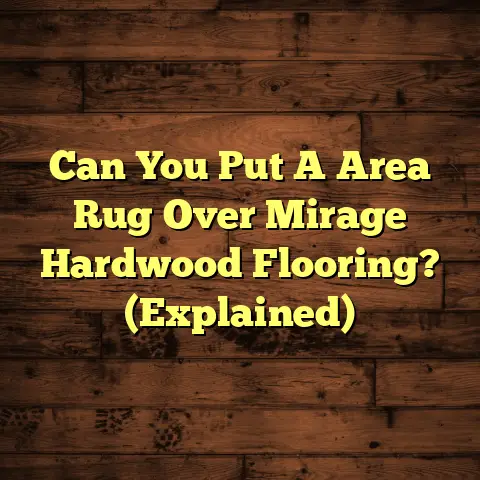Floor Strip & Polish: Essential? (9 Pro Secrets!)
Floors. We walk all over them, sometimes literally! But have you ever stopped to think about how much they contribute to the look, feel, and even the value of your home or business?
I’ve been in the flooring game for over 20 years, and I’ve seen it all – from floors that look like they’ve been through a war zone to floors so shiny you could see your reflection in them.
One thing that’s remained constant throughout the years is the importance of good old-fashioned floor stripping and polishing.
Now, you might be thinking, “Is that really necessary? Isn’t it a bit outdated?” Well, grab a cup of coffee, and let’s dive in. I’m going to share 9 pro secrets that will change the way you think about floor maintenance.
1. Understanding Floor Stripping and Polishing
Okay, let’s get down to brass tacks. What exactly is floor stripping and polishing?
Stripping is the process of removing old layers of wax, sealant, or finish from your floor. Think of it as hitting the reset button, giving you a clean slate.
Polishing, on the other hand, is the process of applying a new finish to protect the floor and give it that beautiful shine.
It’s like giving your floor a spa day!
But here’s the thing: not all floors are created equal. The type of flooring you have will heavily influence whether stripping and polishing is even necessary.
Let’s break it down:
-
Wood: Solid hardwood floors can benefit from stripping and refinishing every 10-15 years, depending on wear and tear. Engineered wood might need it less often, or not at all, depending on the thickness of the veneer.
-
Tile: Ceramic and porcelain tile usually don’t need stripping, but the grout can get grimy. Polishing can help restore shine.
-
Vinyl: Vinyl composition tile (VCT) is a common commercial flooring that definitely benefits from regular stripping and polishing. Sheet vinyl might need it less often.
-
Laminate: Generally, you shouldn’t strip laminate floors. You can damage them. Polishing can help restore shine, but be careful with the products you use.
A Little History Lesson
Flooring maintenance has been around for centuries. Back in the day, people used natural waxes like beeswax to protect and shine their wooden floors.
Over time, we’ve developed more advanced techniques and products, but the basic principle remains the same: protect your investment and keep your floors looking their best.
I remember one time, working on a historic home, we found evidence of old beeswax treatments. It was a cool reminder that some things never go out of style.
2. The Benefits of Floor Strip & Polish
Why bother with all this stripping and polishing, anyway? Well, the benefits are numerous.
-
Aesthetic Appeal: Let’s be honest, a shiny, well-maintained floor just looks better. It makes your whole space feel cleaner and more inviting.
-
Improved Durability: A good finish protects your floor from scratches, scuffs, and stains. This is especially important in high-traffic areas.
-
Increased Property Value: Think about it: when you’re selling your home, potential buyers are going to notice the condition of the floors. Well-maintained floors can definitely increase your home’s value.
-
Health Benefits: Did you know that a clean floor can improve your indoor air quality? Stripping and polishing removes dust, dirt, and allergens that can accumulate over time.
-
Safety: A properly polished floor can actually reduce slip hazards. This is especially important in commercial settings.
I once worked with a client who had severe allergies. After we stripped and polished their floors, they noticed a significant improvement in their symptoms. It’s amazing what a difference a clean floor can make!
3. When is Floor Strip & Polish Necessary?
So, how do you know when it’s time to strip and polish your floors? Here are a few telltale signs:
-
Scratches and Scuffs: If your floors are covered in scratches and scuffs that don’t come out with regular cleaning, it’s time.
-
Dullness: Has your floor lost its shine? Is it looking dull and lifeless? Stripping and polishing can bring back the luster.
-
Discoloration: Are there areas of discoloration or staining that you can’t get rid of? Stripping can remove the old, damaged finish and allow you to start fresh.
-
Buildup: Over time, wax and polish can build up on your floor, creating a cloudy or yellowed appearance.
Frequency of Maintenance
The frequency of stripping and polishing depends on a few factors:
-
Flooring Type: As we discussed earlier, different flooring types have different maintenance needs.
-
Usage Levels: High-traffic areas will need more frequent maintenance than low-traffic areas.
-
Lifestyle: Do you have pets or kids? Do you entertain often? These factors can impact how often you need to strip and polish.
Seasonal Maintenance
In some climates, seasonal maintenance is essential. For example, in areas with harsh winters, floors can accumulate salt and other de-icing chemicals. Stripping and polishing in the spring can help remove these contaminants and protect your floors.
I always tell my clients to think of floor maintenance as an investment. By taking care of your floors, you’re extending their lifespan and saving money in the long run.
4. The Process of Floor Stripping and Polishing
Alright, let’s get into the nitty-gritty. What’s involved in the floor stripping and polishing process?
Step 1: Preparation
-
Clear the Area: Remove all furniture and other obstacles from the area you’ll be working on. This is crucial for safety and efficiency.
-
Sweep and Vacuum: Thoroughly sweep and vacuum the floor to remove any loose dirt and debris.
-
Protect Surroundings: Cover baseboards and other vulnerable areas with painter’s tape or plastic sheeting.
Step 2: Stripping
-
Apply Stripper: Apply a chemical stripper to the floor, following the manufacturer’s instructions.
-
Dwell Time: Allow the stripper to dwell on the floor for the recommended amount of time. This allows it to loosen the old finish.
-
Scrubbing: Use a floor scrubber or a stripping pad to scrub the floor and remove the old finish.
-
Wet Vacuum: Use a wet vacuum to remove the stripping solution and the old finish.
-
Rinse: Rinse the floor thoroughly with clean water to remove any remaining stripper residue.
Step 3: Polishing
-
Apply Polish: Apply a thin, even coat of floor polish to the clean, dry floor.
-
Drying Time: Allow the polish to dry completely, following the manufacturer’s instructions.
-
Buffing: Use a floor buffer with a polishing pad to buff the floor and create a high-gloss shine.
-
Additional Coats: Apply additional coats of polish as needed, allowing each coat to dry completely before buffing.
Tools and Materials
- Floor Stripper
- Floor Polish
- Floor Scrubber or Stripping Pad
- Wet Vacuum
- Floor Buffer
- Polishing Pads
- Painter’s Tape or Plastic Sheeting
- Buckets
- Mops
- Safety Glasses
- Gloves
Safety Precautions
-
Always wear safety glasses and gloves when working with chemical strippers and polishes.
-
Ensure adequate ventilation in the work area.
-
Follow the manufacturer’s instructions for all products.
-
Keep children and pets away from the work area.
DIY vs. Professional
While it’s possible to strip and polish your floors yourself, it’s often best to hire a professional. We have the experience, equipment, and knowledge to do the job safely and effectively.
I’ve seen so many DIY projects go wrong, resulting in damaged floors and wasted money. Sometimes, it’s just better to leave it to the pros.
5. Common Myths About Floor Strip & Polish
Let’s bust some myths about floor stripping and polishing.
-
Myth #1: It’s Only for Old Floors. Not true! Even relatively new floors can benefit from stripping and polishing to remove buildup and protect the finish.
-
Myth #2: It’s Too Expensive. While it’s true that professional floor stripping and polishing can be an investment, it’s often more cost-effective than replacing your floors.
-
Myth #3: It’s Too Time-Consuming. It can be a time-consuming process, especially if you’re doing it yourself. But a professional can often complete the job much faster and more efficiently.
-
Myth #4: It’s Bad for the Environment. While some stripping and polishing products contain harsh chemicals, there are also eco-friendly options available.
-
Myth #5: All Floors Can Be Stripped. As mentioned earlier, some flooring types, like laminate, shouldn’t be stripped. Always check with a professional before attempting to strip your floors.
I remember one client who thought stripping and polishing was a waste of money. After seeing the results, they were amazed at how much better their floors looked. They even said it was like getting a brand-new floor!
6. Pro Secrets for Floor Strip & Polish
Okay, here’s where I spill the beans. These are the pro secrets that will take your floor stripping and polishing game to the next level.
-
Choose the Right Products: This is huge. Don’t just grab the cheapest stripper and polish off the shelf. Do your research and choose products that are specifically designed for your flooring type.
-
Test in an Inconspicuous Area: Before applying any product to your entire floor, test it in a small, hidden area to make sure it doesn’t damage the finish.
-
Prepare the Floor Properly: Thorough cleaning and preparation are essential for achieving the best results. Don’t skip this step!
-
Use the Right Equipment: Investing in quality equipment, like a good floor scrubber and buffer, can make a big difference in the outcome.
-
Apply Thin, Even Coats: Multiple thin coats of polish are better than one thick coat. This will prevent streaks and ensure a more even shine.
-
Allow Adequate Drying Time: Don’t rush the drying process. Allow each coat of polish to dry completely before buffing or applying another coat.
-
Use the Right Buffing Pad: Different buffing pads are designed for different purposes. Use the appropriate pad for your flooring type and the desired level of shine.
-
Maintain Your Equipment: Keep your floor scrubber and buffer clean and in good working order. This will help ensure consistent results.
-
Consult a Professional: When in doubt, don’t hesitate to consult a professional flooring contractor. We can assess your floors, recommend the best products and techniques, and ensure that the job is done right.
I can’t stress enough the importance of choosing the right products. I once saw someone use a stripper that was too harsh for their flooring, and it completely ruined the finish. It was a costly mistake that could have been avoided with a little research.
Conclusion
So, is floor stripping and polishing essential? I think you know my answer. It’s not just a trend; it’s a time-tested way to protect your investment, enhance the beauty of your space, and improve your quality of life.
By adopting the pro secrets I’ve shared in this article, you can achieve amazing results and keep your floors looking their best for years to come.
Don’t underestimate the power of a well-maintained floor. It’s the foundation of your home or business, and it deserves your attention.
I hope this article has been helpful. If you have any questions or need further assistance, don’t hesitate to reach out to a professional flooring contractor in your area.
Happy polishing!





